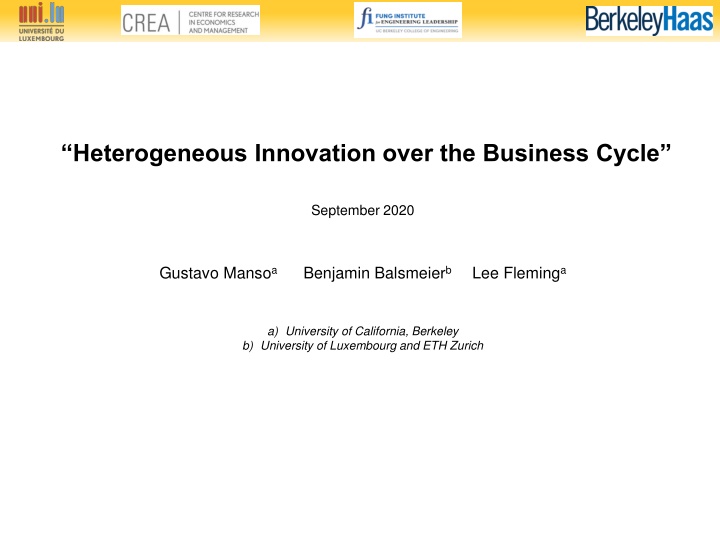
Heterogeneous Innovation Over the Business Cycle Study
Explore the study of heterogeneous innovation over the business cycle, focusing on different types of innovation, the creative destruction puzzle, and various explanations for the observed phenomena. The research delves into the impact of recessions on exploration versus exploitation in innovation, supported by theoretical models and empirical data analysis at both firm and industry levels.
Download Presentation

Please find below an Image/Link to download the presentation.
The content on the website is provided AS IS for your information and personal use only. It may not be sold, licensed, or shared on other websites without obtaining consent from the author. If you encounter any issues during the download, it is possible that the publisher has removed the file from their server.
You are allowed to download the files provided on this website for personal or commercial use, subject to the condition that they are used lawfully. All files are the property of their respective owners.
The content on the website is provided AS IS for your information and personal use only. It may not be sold, licensed, or shared on other websites without obtaining consent from the author.
E N D
Presentation Transcript
Heterogeneous Innovation over the Business Cycle September 2020 Gustavo Mansoa Benjamin Balsmeierb Lee Fleminga a) University of California, Berkeley b) University of Luxembourg and ETH Zurich
Creative Destruction Puzzle Schumpeterian creative destruction theory Cooper & Haltingwanger, 1993; Caballero & Hammour, 1994; Aghion & Saint-Paul, 1998; Canton & Uhlig,1999. Recessions Creative Destruction Evidence, however, goes in the opposite direction Barlevy 2007
Explanations for the Puzzle Credit constraints (Aghion et al. 2007) Risk aversion (Rampini 2004) Externalities in R&D (Barlevy 2007) Delays between invention and commercialization (Schleifer 1986, Francois and Lloyd-Ellis 2003) Greater competition or technological obsolescence (Fabrizio and Tsolmon 2014)
This Study Different types of innovation (exploration versus exploitation) Theoretical model of innovative search (see paper): exploration is more prevalent in recessions because opportunity costs to exploration are lower exploitation is more prevalent in booms firms focus on satisfying current demand Variety of consistent measures Fraction of firm s patents in new to the firm technology classes Derive a new measure of firm level exploration/exploitation (Jaffe 1989)
Gray: NBER defined recessions
Data 1) Joint availability: - public US based firms in Compustat - patent assignee data from Kogan et al. (2017), the USPTO, and the Fung Institute at UC Berkeley (Balsmeier et al. 2018) - NBER-CES Manufacturing Industry Database 2) Restrict sample to firms that we observe at least twice and have non-missing values in innovative search score. 3) The final dataset is an unbalanced panel of 22,040 firm year observations on 1,893 firms in 124 manufacturing industries, observed between 1958 and 2012.
Measure of Exploration/Exploitation Similarity in technological space of firm ? s patents (f) applied in year ? and its pre-existing patents (g) applied between ? 5 and ? 1, using patent counts per USPTO three-digit technology classes ?: ? ?=1 ??,?,???,?,? 1 1 2 ?=1 ?????????? ????? ?,?= 1 1 2 ? 2 ? 2 ?=1 ??,?,? ??,?,? 1 where ??,?,?is the fraction of patents granted to firm ? in year ? that are in technology class ? such that the vector ??,?= ??,1,? ??,?,? locates the firm s year ? patenting activity in ?-dimensional technology space. 0 ?????????? ????? ?,? 1 Exploitation Exploration
Empirical Specification - Estimate effect of changes in industry demand on within firm changes in innovation measures: ?????????????= ?0+ ?1???+ ?2???? 1+ ??+ ????, where ?????????????is a measure of innovation of firm i in industry k and year t, ???is the output in industry k in year t, ??? 1is a vector of one-year lagged firm level controls (R&D spending, sales, employment and property, and plant and equipment per firm), and ?? controls for time-invariant unobserved firm characteristics. - Estimate same model with time fixed effects ??: ?????????????= ?0+ ?1???+ ?2???? 1+ ??+ ??+ ????,
Industry growth, R&D, patents, and innovative search R&D spending Patents Innovative search e a b c d f Log(R&D)t-1 -0.036* 0.044* -0.002 -0.004 (0.022) -0.081*** (0.023) -0.009 (0.003) 0.008 (0.004) 0.011* Log(Sales)t-1 0.232*** 0.152*** (0.030) 0.365*** (0.025) 0.303*** (0.022) 0.470*** (0.021) 0.478*** (0.006) -0.040*** (0.006) -0.057*** Log(Employees)t-1 (0.101) 0.431*** (0.086) 0.272*** (0.061) 0.112*** (0.060) 0.104*** (0.013) -0.028*** (0.013) -0.019*** Log(Capital)t-1 (0.040) 0.372*** (0.043) 21051 No Yes 0.813 (0.031) 0.124*** (0.040) 21051 Yes Yes 0.857 (0.027) 0.130*** (0.033) 21051 No Yes 0.754 (0.025) 0.227*** (0.034) 21051 Yes Yes 0.779 (0.007) -0.036*** (0.006) 21051 No Yes 0.466 (0.007) -0.024*** (0.006) 21051 Yes Yes 0.474 Log(Output)t-1 N Year fixed effects Fim fixed effects R2 Notes: Standard errors clustered at the industry level appear in parentheses. ***, ** and * indicate a significance level of 1%, 5%, and 10%, respectively.
Consistent additional evidence Firms react stronger to business cycle changes the more cyclical the industrial output Firms focus more on process as opposed to product innovations over the cycle Firms are more likely to cite patents in their own patent stock Stronger relationship in industries with shorter lead times Stronger in industries with less appropriation risks (stronger patent effectiveness)
Summary: Puzzle, Solution, Implications R&D and patent counts Schumpeterian Creative Destruction Model of innovative search focuses on different types of innovation Exploration counter-cyclical; exploitation pro-cyclical Introduced metric of firm level exploration/exploitation Recessions are periods of exploration (creative destruction) Booms are periods of exploitation Exploitation => declining dynamism?
